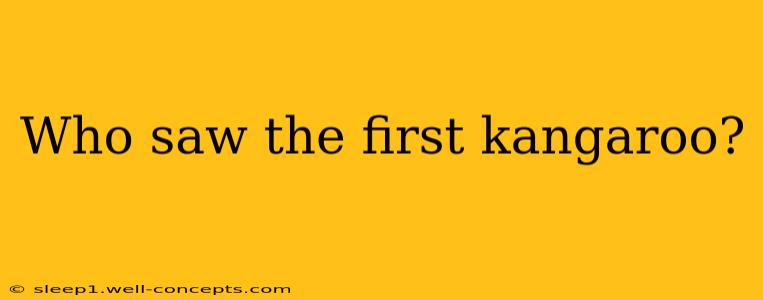The question of who first saw a kangaroo is surprisingly complex, defying a simple, single answer. Unlike the discovery of a newly-found species in a remote jungle today, the first encounter with kangaroos occurred gradually, woven into the fabric of Aboriginal Australian history and then later, European colonial records. There's no single "eureka" moment. Instead, the story unfolds across millennia and involves multiple perspectives.
The Aboriginal Perspective: A Timeless Connection
For tens of thousands of years, Aboriginal Australians have coexisted with kangaroos. Their deep cultural connection to these marsupials is evident in their art, stories, and spiritual beliefs. Many Aboriginal groups have unique names and rich oral histories about kangaroos, detailing their behaviours, importance as a food source, and their place within the Dreamtime. These traditions represent a continuous, intimate relationship with kangaroos that spans far beyond written records. Therefore, attributing the "first sighting" to a specific Aboriginal person or group is impossible and disrespectful to the profound historical link they hold. Their knowledge and understanding predate any European arrival by an immeasurable timeframe.
European Encounters: From Initial Confusion to Scientific Classification
The first recorded European encounters with kangaroos are far more recent, beginning in the late 18th century. While pinpointing the very first European to see a kangaroo is difficult, several key figures played significant roles:
William Dampier: A Fleeting Glimpse?
The English explorer William Dampier, during his voyages in the late 17th century, may have encountered kangaroos, though his accounts are debated. His writings describe large, rat-like creatures, but the identification remains uncertain. The lack of precise descriptions prevents definitive confirmation.
Captain James Cook and Joseph Banks: More than a Glimpse
Captain James Cook's expedition in 1770 is often associated with the "discovery" of kangaroos for the Western world, primarily due to the detailed accounts of botanist Joseph Banks who accompanied him. Banks' meticulous observations and descriptions, along with sketches, provided the European scientific community with their first substantial information about these unique marsupials. This is why Banks is frequently mentioned in relation to the "discovery," though it's crucial to understand this is a discovery within the framework of European scientific understanding, not the initial encounter.
Beyond the Initial Observations: Scientific Naming
Later, the French zoologist Georges Cuvier would formally classify and name the kangaroo, Macropus, solidifying its place in the Western scientific lexicon. However, this act of classification doesn't diminish the extensive knowledge already possessed by Aboriginal Australians.
A Shared History, Diverse Perspectives
Ultimately, the question of "who saw the first kangaroo?" lacks a satisfying singular answer. The long-standing relationship between Aboriginal Australians and kangaroos is a continuous narrative stretching back millennia, while European encounters represent a comparatively recent chapter in a shared history. Understanding this nuanced story demands recognizing and respecting both perspectives: the deep-rooted knowledge of the Aboriginal people and the contributions of European explorers and scientists in recording and classifying these remarkable animals for the Western world. It’s a tale of interwoven histories, emphasizing the importance of acknowledging the Indigenous perspective as paramount.

